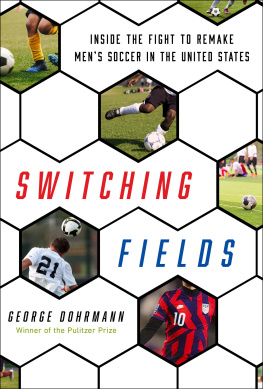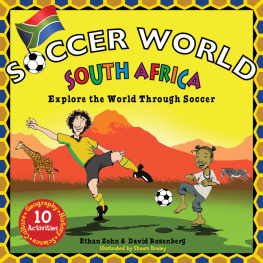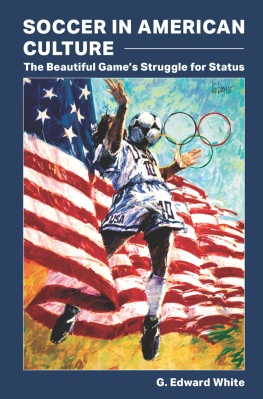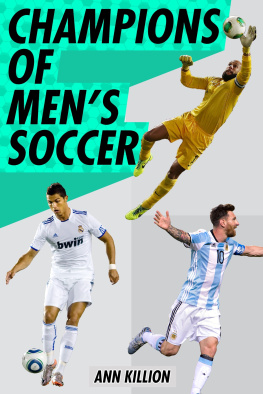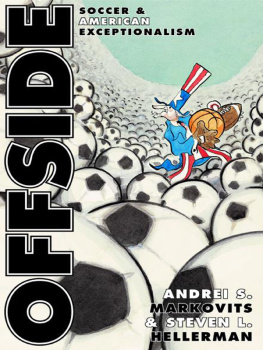Soccer around the World
A Cultural Guide to The Worlds Favorite Sport
Charles Parrish
John Nauright

Copyright 2014 ABC-CLIO, LLC
All rights reserved. No part of this publication may be reproduced, stored in a retrieval system, or transmitted, in any form or by any means, electronic, mechanical, photocopying, recording, or otherwise, except for the inclusion of brief quotations in a review, without prior permission in writing from the publisher.
Library of Congress Cataloging-in-Publication Data
Parrish, Charles.
Soccer around the world : a cultural guide to the worlds favorite sport / Charles Parrish.
pages cm
ISBN 978-1-61069-302-8 (hardback) ISBN 978-1-61069-303-5 (ebook)
1. SoccerJuvenile literature. 2. SoccerSocial aspectsJuvenile literature. I. Title.
GV943.25.P37 2014
796.334dc23
2013051345
ISBN: 978-1-61069-302-8
EISBN: 978-1-61069-303-5
18 17 16 15 14 1 2 3 4 5
This book is also available on the World Wide Web as an eBook.
Visit www.abc-clio.com for details.
ABC-CLIO, LLC
130 Cremona Drive, P.O. Box 1911
Santa Barbara, California 93116-1911
This book is printed on acid-free paper 
Manufactured in the United States of America
Soccer around the World
Soccer around the World
A CULTURAL GUIDE TO THE WORLDS FAVORITE SPORT
CHARLES PARRISH AND JOHN NAURIGHT
ABC-CLIO
Santa Barbara, California Denver, Colorado Oxford, England
In memory of lifelong educator, mentor, and friend, George H. Bedwell (19382012)
Although I never convinced you otherwise, soccer is indeed much more than a good cure for insomnia.
Contents
Preface
Despite the subtitle of this book, soccer is much more than simply the worlds favorite sport. Throughout these pages we highlight the cultural significance of soccer in various regions across the globe. As the reader will find, soccer both reflects and helps shape our perception of societies, past and present. Evolving from a simple diversion and character-building tool to a global commercial industry, the sport now functions as a cohesive (and divisive) global spectacle, a means by which to assert personal and collective identities, an effective and at times controversial political tool for international diplomacy, an integral component of contemporary strategies seeking to forge economic and social development, and a showpiece nations construct as a means to display economic and technical achievements. Of course, the global business element is of paramount importance, and as we progress with haste in the 21st century, the global soccer industry faces a unique set of challenges to its welfare as well as opportunities for future growth.
Some have argued that the consumption of soccer, though difficult to measure, surpasses that of any other cultural product. With 3.2 billion people (nearly half of the worlds population) tuning in to watch the 2010 FIFA World Cup on television it is becoming increasingly difficult to refute such a claim. The final match between Spain and the Netherlands alone drew a total viewership of approximately 1 billion. Countless others play the game at some level, whether informally, through organized recreation, or by way of serious competition. As people around the world now incorporate soccer into their routines, the sport has become an important facet of everyday life worthy of analysis. In doing so, we are able to better understand not only its local cultural and social significance but also its much broader global impact. Through serious analysis and reflection we can derive useful conclusions that, in the end, provide a holistic window into the past, present, and future.
This book is organized alphabetically by country. Space limitations do not allow for the inclusion of every soccer-playing nation. Along with the editors, we were forced to engage in a strenuous and reflective process when deciding which countries to include and which clubs, personalities, and events to profile. Consequently, we anticipate some debate on our choices and openly accept the critique. Soccer around the World: A Cultural Guide to the Worlds Favorite Sport provides the reader with key information about the traditional soccer powers of Europe and South America as well as overview profiles on nations where the sport has recently emerged as a popular spectacle. Further, with more than 29 million registered women and girls playing competitive soccer worldwide, the impact of soccer on women and the impact women are having on soccer are important and valuable topics to explore. In support of the enduring movement to address gender bias, and despite the imbalance of literature available, we have included information on the status and significance of the womens game. Although some essays on womens soccer will be more in depth than others, it should not be inferred that this is indicative of cultural significance in a comparative sense, nor of the value we personally give to womens soccer. Information about womens soccer is simply more accessible in some regions than in others. Should our effort here be deemed insufficient, we can only hope it will inspire others to fill the void now and in the future. Within the next generation we hope many more opportunities will appear for women and girls to play soccer around the world, and we can produce an entire volume on women alone.
It is our goal to provide readers with an enjoyable piece of literature to read in one sitting or across multiple readings. We hope it will prove to be a useful tool with which to better understand and engage with the changing world around us. Much has been written about the positive and negative impacts of globalization, a process that began with the Columbian Exchange. Some have suggested that this ongoing process is forging a more homogenous society, while others argue that it is creating more diverse hybrid cultures. We do not seek to settle this debate here. However, we do suggest that soccer both reflects and contributes to the globalization process, regardless of its residual effects.
Charles Parrish
Warrenton, Virginia, USA
John Nauright
Rye, East Sussex, England
November 2013
Acknowledgments
Throughout the duration of this project we have received much needed support from a variety of sources. To begin we would like to acknowledge the patience of and assistance from the editors and production team at ABC-CLIO. The ink had just begun to dry on our edited four-volume reference work, Sports around the World: History, Culture, and Practice, when we were presented with the idea of writing a follow-up text that focused specifically on soccer to appear at the time of the 2014 FIFA World Cup in Brazil. After some deliberation we gratefully accepted the opportunity, not solely because we are both covert soccer fanatics, but because of the professional manner in which ABC-CLIO managed the earlier project. We understood from the very beginning that we would receive excellent editorial support and that the production process would be efficient. As expected, Kaitlin Ciarmiello, Erin Ryan, and their ABC-CLIO colleagues saw this project through with the utmost level of professionalism.
Another group that deserves acknowledgment is the dedicated team of librarians, archivists, and circulation specialists at George Mason University (GMU) as well as those working within the Washington Research Library Consortium network. Their timely efforts in locating, acquiring, and circulating the large quantity of texts and articles used in support of this book were critical to its completion.


